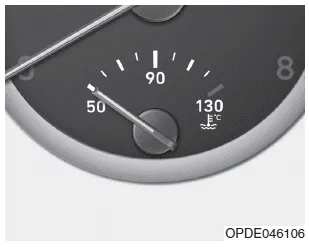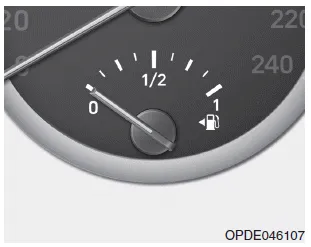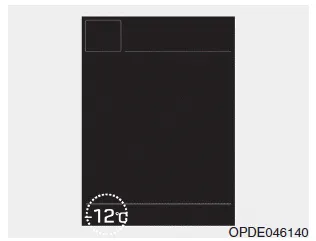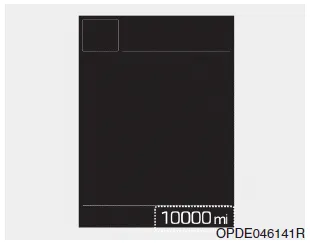Hyundai i30 (PD): Instrument cluster / Gauges and meters
Speedometer

The speedometer indicates the speed of the vehicle and is calibrated in kilometers per hour (km/h) and/or miles per hour (MPH).
Tachometer

The tachometer indicates the approximate number of engine revolutions per minute (rpm).
Use the tachometer to select the correct shift points and to prevent lugging and/or over-revving the engine.
NOTICE
Do not operate the engine within the tachometer's RED ZONE. This may cause severe engine damage.
Engine coolant temperature gauge

This gauge indicates the temperature of the engine coolant when the ignition switch is in the ON position.
NOTICE
If the gauge pointer moves beyond the normal range area toward the "130" position, it indicates overheating that may damage the engine.
Do not continue driving with an overheated engine. If your vehicle overheats, refer to "If the Engine Overheats" in chapter 6.
WARNING
Never remove the radiator cap when the engine is hot. The engine coolant is under pressure and could cause severe burns. Wait until the engine is cool before adding coolant to the reservoir.
Fuel gauge

Information
- The fuel tank capacity is given in chapter 8.
- The fuel gauge is supplemented by a low fuel warning light, which will illuminate when the fuel tank is nearly empty.
- On inclines or curves, the fuel gauge pointer may fluctuate or the low fuel warning light may come on earlier than usual due to the movement of fuel in the tank.
WARNING
Running out of fuel can expose vehicle occupants to danger.
You must stop and obtain additional fuel as soon as possible after the warning light comes on or when the gauge indicator comes close to the "0" level.
NOTICE
Avoid driving with an extremely low fuel level. Running out of fuel could cause the engine to misfire damaging the catalytic converter.
Outside temperature gauge

This gauge indicates the current outside air temperatures either in Celsius (°C) or Fahrenheit.
- Temperature range : -40°C ~ 60°C (-104°F ~ 140°F)
The outside temperature on the display may not immediately change like a general thermometer not to distract the driver.
The temperature unit (from °C to °F or from °F to °C) can be changed by:
- User Settings mode in the Cluster :
You can change the temperature
unit in the “Other Features -
Temperature unit” .
- Automatic climate control system :
Whilst pressing the OFF button,
press the AUTO button for 3 seconds
or more.
The temperature unit of the instrument cluster and climate control system will change at once.
Odometer

The odometer indicates the total distance that the vehicle has been driven and should be used to determine when periodic maintenance should be performed.
Distance to empty

- The distance to empty is the estimated distance the vehicle can be driven with the remaining fuel.
- If the estimated distance is below 1 mi. (1 km), the trip computer will display “---” as distance to empty.
Information
- If the vehicle is not on level ground or the battery power has been interrupted, the distance to empty function may not operate correctly.
- The distance to empty may differ from the actual driving distance as it is an estimate of the available driving distance.
- The trip computer may not register additional fuel if less than 6 litres (1.3 lmp. gal.) of fuel are added to the vehicle.
- The distance to empty may vary significantly based on driving conditions, driving habits, and condition of the vehicle.
Instrument panel illumination When the vehicle's position lights or headlamps are on, press the illumination control button to adjust the brightness of the instrument panel illumination.
Manual transmission shift indicator This indicator informs which gear is recommended whilst driving, to save fuel. Shifting up : ▲2, ▲3, ▲4, ▲5, ▲6 Shifting down :▼1, ▼2, ▼3, ▼4, ▼5 For example : Indicates that shifting up to the 3rd gear is recommended (currently the shift lever is in the 2nd or 1st gear).
Other information:
Hyundai i30 (PD) 2018-2024 Owner's Manual: Check tyre pressure
You can check the tyre pressure in the Assist mode on the cluster. Refer to the "LCD Display Modes" in chapter 3. Tyre pressure is displayed after a few minutes of driving after initial engine start up. If tyre pressure is not displayed when the vehicle is stopped, "Drive to display" message will appear.
Hyundai i30 (PD) 2018-2024 Owner's Manual: Exhaust emission control system
The Exhaust Emission Control System is a highly effective system which controls exhaust emissions whilst maintaining good vehicle performance. Vehicle modifications This vehicle should not be modified. Modification of your vehicle could affect its performance, safety or durability and may even violate governmental safety and emissio
Categories
- Manuals Home
- Hyundai i30 Owners Manual
- Horn
- Cargo area cover
- Air bag - supplemental restraint system
- New on site
- Most important about car
